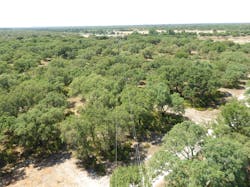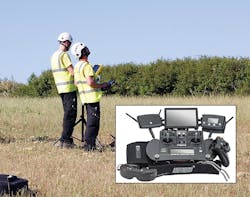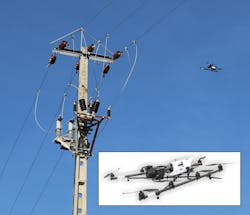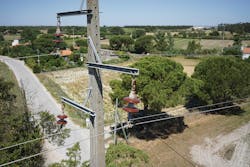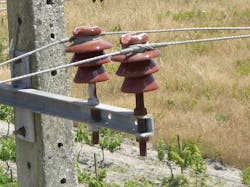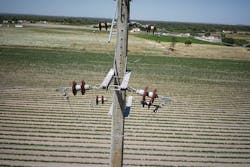Portugal Employs UAVs to Inspect Overhead Lines
EDP Distribuição, the largest distribution utility in Portugal has a large high-voltage and medium-voltage (HV/MV) overhead line network that extends over a vast geographical area. Therefore, the management of this asset is an extremely expensive exercise that is constantly under review to ensure all the industry’s network reliability and safety standards are met.
This challenging task can be undertaken in various ways, which in the past have included visual overhead line inspection of components by foot patrols and more recently using the light detection and ranging (LiDAR) services now available from numerous contractors. Each of these methods can be effective in identifying the need to replace time-expired overhead line components and the locations where safety clearances fail to satisfy industry standards because of vegetation growth and newly constructed buildings.
Utilities regularly review the annual cost of collecting and collating this information, which forms the work database required to determine the annual revenue budget and the overhead line maintenance staff resources needed to complete the identified work load. The advent and expanded range of services that can be undertaken by unmanned aerial vehicles (UAVs), therefore, has attracted the interest of EDP Distribuição as a cost-effective means of undertaking aerial inspection of the existing HV and MV overhead line networks.
UAVs for Inspection
The use of UAV technology enables the collection of up-to-date, accurate information in a short time span, often in locations where human access and working conditions are difficult. It increases the speed of data collection and reduces operation costs and the risks of accidents. One of EDP’s major concerns is the safety of staff on site, so working with UAVs will substantially decrease the chance of accidents. This technology can be employed and tailored to complement infrastructure operation and maintenance services. Also the quality of images obtained from different angles can provide EDP with a more detailed overview of potential defects, and real-time inspection gives the utility the opportunity to take instant action on an operation and maintenance procedure.
EDP Distribuição entered into a partnership agreement with Construção e Manutenção Electromecánica, S.A. (CME) for the provision of construction and maintenance services for EHV/HV/MV overhead lines. This agreement made provision for CME to develop a specialized range of services for this application and the implementation of these technologies on two pilot projects, a 15-kV MV overhead line and a 60-kV HV overhead line.
Range of Services
Photographic inspection — the capturing of photographs and video images of overhead lines — can provide highly detailed inspection information. This is essential for the identification of common problems on poles and their elements, such as conductors, insulators and pole-mounted equipment. In addition to identifying the main problems, photographic inspection also provides solutions for the problems recorded. This task is carried out in real time using a data transmitter-receiver. Currently, Portuguese legislation restricts the operation of UAVs to the line of sight that limits the use of this equipment to a range of 500 m (1640 ft).
Thermographic inspection is important as it identifies evidence of the overheating of any of the overhead line components. Likewise, the creation of a digital terrain model allows for the efficient design of new and existing overhead lines, and the data collected can be used for detailed design mapping. Malfunction reports summarize the inspection results and identify the main problems.
LiDAR readings allow for the use of this data in the design of the line and also for the identification of conductor proximity risks such as vegetation, new buildings and intersection with other lines. It also enables the inspection of all overhead line assets, the collection of data for integration into a geographic information system (GIS) platform as well as detailed updating of existing infrastructure.
One of the most important tasks in the preventive maintenance of overhead lines is controlling the vegetation’s proximity and height with respect to the live conductors. With this service, it is possible to present preventive maintenance reports and avoid common problems, such as trees falling over the conductors, flora identification, growth-rate calculations and cutting, among other aspects.
The UAV platform is equipped with the most advanced sensors, such as thermal and photographic video cameras. These allow real-time data to be sent simultaneously to the equipment’s operator and to EDP Distribuição’s control center for review and analysis.
Online Platform
All the data collected on site are made available on a WebGIS platform. Thus, the overhead line inspected can be analyzed on a daily basis in real time. Images, videos, thermograms and inspection reports are updated in real time on the platform, either directly from the site, through an internet connection, or from the control center. The data collected is represented in a structured and intuitive manner to make it possible for any technician or non-technician to analyze them.
Data and access to the platform can be managed by access control, which in turn will make it possible to manage the display according to user profile. Different divisions will have different edition and/or visualization levels. This also happens on a higher level with different distribution utility operators who access the platform, each being allowed only to display their own overhead line network.
Data Collection
CME’s experience in overhead line construction and maintenance work makes it possible to develop a research matrix that defines intuitive and thorough inspection. Early on, a meeting with EDP Distribuição defined the inspection rules. Inspections may be preventive to assess the technical condition of the asset under analysis through unprogrammed actions.
Following data collection and analysis, intervention times for performing any necessary changes to the overhead line and its components can be assessed. These actions can be classified according to criticality levels, which range from very low risk (not requiring intervention) to high risk (actions that must be carried out in the short term).
Pilot Projects
CME and its partner Cyberhawk developed the technologies for two pilot projects in EDP Distribuição. Two existing overhead lines (15 kV and 60 kV) were selected for the photographic and thermographic inspection.
For the inspection of the overhead lines, CME used a Falcon 8 with eight engines and a 750-g (1.6-lb) payload. This UAV can be operated in wind speeds of up to 15 m/s (49 ft/s), maintaining a stable position (GPS mode) up to 12 m/s (39 ft/s). The Falcon 8 may be used with the following sensors/cameras:
- Sony Alpha 7R 36.4-megapixel, 60p video full-HD digital photographic camera
- Inspection package made up of a Panasonic Lumix DMC-TZ61 digital camera and a FLIR Tau 2 640 thermographic camera with 19-mm lenses
- Sony PJ780VE camera with 1920 x 1080/50p full-HD video.
The remote control of the equipment is done through a mobile control station with flight data and equipment real-time display. The results of the overhead line inspection of both circuits were later made available on a WebGIS platform, which allowed EDP Distribuição to check the grid assets in a structured and streamlined manner.
Pilot Results
The UAV photographic inspection of the Faias 15-kV overhead line revealed signs of deterioration on some of the concrete supporting towers, as the reinforcing steel bars were visible from the base to the upper sections of the tower. Also, there was a trend of moderate to severe rust on the U-bolts used to support the insulators.
Inspection also identified trees in close proximity to the live overhead line conductors, poor and unreadable safety signs, and deterioration of the paintwork and galvanizing on the structural members of the towers. The thermal inspection confirmed that the majority of the overhead line components were within acceptable temperature limits with only a few recording temperatures above average.
The UAV photographic survey of the Fanóes-Mafra 60-kV overhead line confirmed the majority of the towers were in good condition. However, on some towers, deterioration in the form of exposed steel-reinforcing bars was identified from the base to the upper section of the towers. Also, safety signs were shown to be in poor condition, and the paintwork and galvanizing of some tower structural members was also deteriorating. The thermal inspection of the insulator live end components conducted at each tower position confirmed that the majority of components were thermally sound with higher than average temperatures being recorded on components on just two towers.
Encouraging Application
The application of UAVs has given EDP a greater insight into the condition of overhead line components not usually identified by the ground patrol staff. This improved quality of information could reduce the probably of incidents arising from live-line work and overhead linemen working at heights. To date, because of the lack of major storms, it has not been possible for EDP to employ UAVs for post-storm damage inspection. Overall, based on the encouraging success and results of the two pilot pro-jects, EDP is considering expanding the use of UAVs for overhead line inspections.
Acknowledgement
The author wishes to thank Malcolm Malveiro of CME for his technical assistance in the preparation of this article. ♦
Jorge Polvora Fialho joined EDP Distribuição in 2002, and since 2007, he has been working with the maintenance department responsible for the high- and medium-voltage networks. He has participated in projects related to technical asset management and performance monitoring in electrical networks.
About the Author
Jorge Polvora Fialho
Jorge Polvora Fialho joined EDP Distribuição in 2002, and since 2007, he has been working with the maintenance department responsible for the HV and MV networks. He has participated in projects related to technical asset management and performance monitoring in electrical networks. Fialho studied electrical engineering at the High Institute of Engineering of Lisbon and business management at the School of Technology and Management of Beja.
